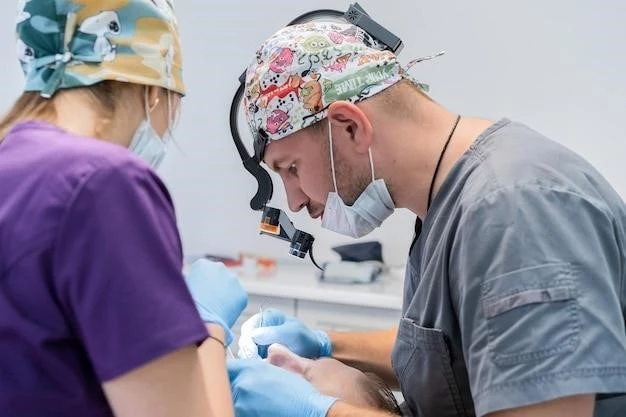Introduction
Microcephaly lymphoedema chorioretinal dysplasia (MLCRD) syndrome is a rare genetic condition characterized by microcephaly‚ lymphoedema‚ and chorioretinal changes․
Description of Microcephaly Lymphoedema Chorioretinal Dysplasia Syndrome
The syndrome involves microcephaly‚ lymphoedema‚ and chorioretinal dysplasia․ It may present with congenital heart defects‚ facial features‚ and visual deficits․ The genetic component includes mutations in the KIF11 gene․
Patient cases show phenotypic overlap with CDMMR syndrome‚ with autosomal-dominant inheritance․ The syndrome’s variable expression and clinical presentations make diagnosis and management challenging․
Families with affected individuals may exhibit familial patterns of visual deficits and chorioretinal changes․ Recent genetic studies have shed light on the underlying mutations‚ aiding in the understanding and diagnosis of this complex syndrome․
The syndrome presents with distinctive facial features‚ congenital heart defects‚ and visual deficits due to chorioretinal changes․ There is notable phenotypic overlap with CDMMR syndrome․
Facial Features and Congenital Heart Defects
Patients with MLCRD syndrome exhibit distinct facial features and may present with various congenital heart defects․ Understanding these characteristics is crucial for the diagnosis and management of individuals affected by this complex genetic syndrome․
Phenotypic Overlap with CDMMR Syndrome
There is significant phenotypic overlap between MLCRD syndrome and CDMMR syndrome․ Both exhibit autosomal-dominant inheritance and a variable spectrum of CNS and ocular manifestations․ The identification of mutations in the KIF11 gene has provided insights into these genetic conditions․
Notably‚ familial cases have shown chorioretinal dysplasia with variable visual deficits‚ supporting the concept of MLCRD as a single autosomal dominant genetic entity with diverse clinical expressions․ Recent studies highlight the genetic basis of these syndromes‚ aiding in accurate diagnosis and management․
Genetic Components
The syndrome’s genetic component includes mutations in the KIF11 gene․ It exhibits autosomal-dominant inheritance and variable expression‚ impacting CNS and ocular manifestations․
Autosomal-Dominant Inheritance
The MLCRD syndrome demonstrates autosomal-dominant inheritance patterns with variable CNS and ocular manifestations․ Mutations in the KIF11 gene play a crucial role in the genetic component of this syndrome‚ impacting its phenotypic expression․
Characteristics of the Syndrome
The syndrome manifests with unique facial features‚ congenital heart defects‚ and visual deficits due to chorioretinal changes․ It exhibits phenotypic overlap with CDMMR syndrome․

Clinical Presentations
Patients with MLCRD syndrome may experience visual deficits due to chorioretinal changes․ The syndrome’s expression may vary among affected individuals and their relatives․
Mutations in KIF11 Gene
Researchers have identified mutations in the KIF11 gene as a key factor in the development of Microcephaly Lymphoedema Chorioretinal Dysplasia Syndrome․ These mutations can lead to variable phenotypic expressions‚ affecting both ocular and central nervous system manifestations of the syndrome․
Variable Expression in Relatives
Familial cases with microcephaly‚ lymphedema‚ and chorioretinal dysplasia show variable expressions of visual deficits and chorioretinal changes․ This variability supports the concept of a single autosomal dominant genetic entity with diverse clinical presentations․
Diagnosing MLCRD may involve assessing the characteristic visual deficits and chorioretinal changes‚ distinguishing it from related syndromes like CDMMR by analyzing the distinct genetic components․
Distinguishing MLCRD from CDMMR Syndrome
It is crucial to differentiate between Microcephaly Lymphoedema Chorioretinal Dysplasia (MLCRD) and Chorioretinal Dysplasia‚ Microcephaly‚ and Mental Retardation (CDMMR) syndromes․ Both syndromes exhibit autosomal-dominant inheritance and a spectrum of central nervous system and ocular manifestations‚ necessitating genetic analysis for accurate diagnosis․

Diagnosis and Differential Diagnosis
Diagnosing Microcephaly Lymphoedema Chorioretinal Dysplasia (MLCRD) involves assessing characteristic visual deficits and chorioretinal changes while distinguishing it from related syndromes like Chorioretinal Dysplasia‚ Microcephaly‚ and Mental Retardation (CDMMR)․
Management and Prognosis
Ophthalmologic evaluations are crucial for patients with MLCRD to assess and treat visual deficits resulting from chorioretinal changes․ The long-term outlook varies due to the syndrome’s diverse clinical presentations․
Ophthalmologic Evaluations and Treatment
Patients diagnosed with Microcephaly Lymphoedema Chorioretinal Dysplasia may require ophthalmologic assessments to monitor and address visual deficits resulting from chorioretinal changes․ Treatment strategies may focus on managing the ocular manifestations associated with the syndrome to improve long-term visual outcomes․
Long-Term Outlook for Patients
The long-term outlook for patients with Microcephaly Lymphoedema Chorioretinal Dysplasia may vary depending on the syndrome’s diverse clinical presentations․ Regular ophthalmologic evaluations and treatments can help manage visual deficits associated with chorioretinal changes‚ potentially improving the overall prognosis for affected individuals․
Research and Studies
Recent studies focus on the genetic mutations and diverse clinical presentations of Microcephaly Lymphoedema Chorioretinal Dysplasia syndrome for better understanding and accurate diagnosis․
Recent Findings and Publications
Recent studies have focused on the genetic mutations and clinical presentations of Microcephaly Lymphoedema Chorioretinal Dysplasia syndrome‚ shedding light on its complex nature and potential diagnostic advancements․
Investigations on Genetic Mutations
Studies have focused on the genetic mutations underlying Microcephaly Lymphoedema Chorioretinal Dysplasia․ Mutations in the KIF11 gene have been linked to the syndrome’s phenotypic variability․
